Free Software/Free Culture Collaboration
- 1. LinuxWorld 2008-08-05 Free Software/Free Culture Collaboration Mike Linksvayer Vice President, Creative Commons Image by Lawmaker Licensed under CC Attribution-ShareAlike 2.0 http://flickr.com/photos/lawmaker/215782074/
- 2. ToC Affiliation Software/Culture Freedom History Indicators Let us help each other
- 3. Creative Commons .ORG Nonprofit organization, launched to public December 2002 HQ in San Francisco (around the corner) Science Commons division in Boston ~60 international jurisdiction projects, coordinated from Berlin Foundation, corporate, and individual funding
- 4. Enabling Reasonable Copyright Space between ignoring copyright and ignoring fair use & public good Legal and technical tools enabling a “Some Rights Reserved” model Like “free software” or “open source” for content/media But with more restrictive options Media is more diverse and at least a decade(?) behind software
- 9. Machine Readable <rdf:RDF xmlns="http://creativecommons.org/ns#" xmlns:rdf="http://www.w3.org/1999/02/22-rdf-syntax-ns#"> <License rdf:about="http://creativecommons.org/licenses/by-nc-sa/3.0/nl/"> <permits rdf:resource="http://creativecommons.org/ns#Reproduction"/> <permits rdf:resource="http://creativecommons.org/ns#Distribution"/> <requires rdf:resource="http://creativecommons.org/ns#Notice"/> <requires rdf:resource="http://creativecommons.org/ns#Attribution"/> <prohibits rdf:resource="http://creativecommons.org/ns#CommercialUse"/> <permits rdf:resource="http://creativecommons.org/ns#DerivativeWorks"/> <requires rdf:resource="http://creativecommons.org/ns#ShareAlike"/> </License> </rdf:RDF>
- 10. Machine Readable (Work) <span xmlns:cc="http://creativecommons.org/ns#" xmlns:dc="http://purl.org/dc/elements/1.1/"> <span rel=" dc:type " href=" http://purl.org/dc/dcmitype/Text " property=" dc:title " > My Book </span> by <a rel=" cc:attributionURL " property=" cc:attributionName " href=" http://example.org/me "> My Name </a> is licensed under a <a rel=" license " href=" http://creativecommons.org/licenses/by/3.0/ " >Creative Commons Attribution 3.0 License</a>. <span rel=" dc:source " href=" http://example.net/her_book " /> Permissions beyond the scope of this license may be available at <a rel=" cc:morePermissions " href=" http://example.com/revenue_sharing_agreement ">example.com</a>. </span>
- 11. Rights Description vs. Rights Management Copy/use promotion vs. copy/use protection Encourage fans vs. discourage casual pirates Resource management vs. customer management Web content model vs. 20 th century content model Not necessarily mutually exclusive
- 12. DRMfree “ DRM Voodo” by psd licensed under CC BY 2.0 http://flickr.com/photos/psd/1806247462/
- 13. CC RecentChanges 5½ years old CEO/Legal/Funding CC0 ccLearn RDFa/ccREL liblicense and licensechooser.js Case Studies Project Metrics Project (estimated minimum 130 million CC licensed works)
- 14. Software/Culture (i) Utilitarian/obvious but narrow reuse vs non-utilitarian but universal reuse possible Gecko in Firefox, Thunderbird, Songbird... = Obvious Device driver code in web application = Huh? Cat photos and heavy metal = music video
- 15. Software/Culture (ii) Maintenance necessary vs rare Non-maintained software = dead “Maintained” cultural work = pretty special (Wikis are somewhat like software in this respect)
- 16. Software/Culture (iii) Roughly all or nothing modifiable form vs varied and degradable forms You have the source code or you don’t Text w/markup > PDF > Bitmap scan Multitracks > High bitrate > Low bitrate
- 17. Software/Culture (iv) Construction is identical to creating modifiable form vs. iteratively leaving materials on the cutting room floor
- 18. Freedom (i) Software Debian Free Software Guidelines Open Source Definition Free Software Definition Open Software Service Definition (new, and more than just software)
- 19. Freedom (ii) Why? User autonomy Sharing ethic Facilitates collaboration, unlocks value, makes distributed maintenance tenable
- 20. Freedom (iii) Does culture need freedom? As in free software? The Definition of Free Cultural Works (freedomdefined.org) says yes The easier it is to re-use and derive works, the richer our cultures become. ... These freedoms should be available to anyone, anywhere, anytime. They should not be restricted by the context in which the work is used. Creativity is the act of using an existing resource in a way that had not been envisioned before.
- 21. Freedom (iv) Four freedoms for works of authorship according to t he Definition of Free Cultural Works : the freedom to use the work and enjoy the benefits of using it the freedom to study the work and to apply knowledge acquired from it the freedom to make and redistribute copies , in whole or in part, of the information or expression the freedom to make changes and improvements , and to distribute derivative works
- 22. Freedom (v) Definition of Free Cultural Works Wikipedia/Wikimedia licensing policy Recognized (reciprocally) by CC licenses “Approved for Free Cutural Works” (PD, BY, BY-SA)
- 23. Freedom (vi) So why NoDerivatives and NonCommercial? Legal sharing of verbatim works made interesting by filesharing wars Maybe less emphasis on maintenance means Restrictions on field of use less impactful Free commercial use more impactful on existing business models
- 24. Freedom (vii) Commercial anticommons When distributed maintenance is important, NC is unusable for business (one explanation of why free software =~ open source) Maybe some artists want a commercial anticommons: nobody can be “exploited” ... but most want to exploit commerce. NC maybe does both.
- 25. Freedom (viii) For some communities free as in free software is not free enough Science Commons Protocol for Implementing Open Access Dat a
- 26. Freedom (ix) Copyleft scope or “strength” ... a theme Permissive < LGPL < GPL < AGPL < copyleft the world For culture, what constitutes an adaptation that triggers copyleft (ShareAlike)? If goal is to expand free universe, optimal copyleft is where underuse opportunity cost cancels out vacuum effect at the margin ... have there been experiments?
- 27. History (i) Some evocative dates for software ... 1983: Launch of GNU Project 1989: GPLv1 1991: Linux kernel, GPLv2 1993: Debian 1996: Apache 1998: Mozilla, “open source”, IBM
- 28. History (ii) ... evocative dates for software 1999: crazine$$ 2004: Firefox 1.0 2007: [A]GPLv3 ????: World Domination
- 29. History (iii) Open content licenses (some of them Free): 1998: Open Content License 1999: Open Publication License 2000: GFDL, Free Art License 2001: EFF Open Audio License
- 30. History (iv) Other early 2000s open content licenses (some of them Free): Design Science License, Ethymonics Free Music Public License, Open Music Green/Yellow/Red/Rainbow Licenses, Open Source Music License, No Type License, Public Library of Science Open Access License, Electrohippie Collective's Ethical Open Documentation License
- 31. History (v) Versioning of Creative Commons licenses (some of them Free): 2002: 1.0 2004: 2.0 2005: 2.5 2007: 3.0
- 32. History (vi) Anti-proliferation? 2003: author of Open Content/Publication licenses recommends CC instead and PLoS adopts CC BY 2004: EFF OAL 2.0 declares CC BY-SA 2.0 its next version No significant new culture licenses since 2002 2008: Possible Wikipedia migration to CC BY-SA
- 33. Indicators (community) 1993: Debian :: 2001 : Wikipedia 8 years Wikipedia’s success came faster and more visibly Does Wikipedia even need an Ubuntu (2004)? But how typical is Wikipedia of free culture?
- 34. Indicators (business) 1989: Cygnus Solutions :: 2003 : Magnatune 14 years Cygnus acquired by Red Hat (1999); Magnatune’s long term impact TBD Magnatune may not be Free enough for some, but it seems like the best analogy
- 35. Indicators (big business) 1998: IBM :: ???? : ? No analogous investments have been made in free culture. Most large computer companies have now made large investments in free/open source software 1998: Microsoft :: 2008 : Big Media Could Microsoft’s attitude toward openness a decade ago be analogous to big media’s today?
- 36. Indicators (Wikitravel) Very cool round-trip story: 2003: Launch, CC BY-SA 2006: Acquired by Internet Brands 2008: First Wikitravel Press paper titles Community is the new “IP”?
- 37. Indicators (NIN) Ghosts I-IV released 2008 under CC BY-NC-SA: $1.6m gross in first week $750k in two days from limited edition “ultra deluxe edition” This while available legally and easily, gratis. NC doesn’t seem important in this story ... yet
- 38. Indicators (Summary Guesses) Free culture is at least a decade behind free software Except where it has mass collaboration/maintenance aspects of software, where it may rocket ahead (Wikipedia) Generally culture is much more varied than software; success will be spikey
- 39. Why Free Software/Free Culture Collaboration?
- 41. Why? Proprietary culture seems to create demand for things that break free software (DRM, closed media formats, proprietary software only access) Proprietary software seems to foster things that cripple free culture (DRM, favored access for proprietary culture) Shared interest not only in (defeating) DRM and other common enemies...
- 42. Knowledge and stories mutually reinforcing “ We” are still learning how to make openness work better (always will be) Stories spread that knowledge and convince others that freedom is good Create demand for user autonomy
- 43. General problems to work on together Open formats (and by extension, software patents ) Free media creation tools “ Open media web” – open formats, URL addressable Free culture distribution/discovery How to make more cultural production more wiki-like (i.e. software-like)?
- 44. A few currently interesting projects (large and small, of many...) Wikimedia Commons (and Wiki[mp]edia generally) Amarok, Banshee, Gnash, Miro, Rhythmbox, Songbird & co. (free software media players) liblicense and other CC software projects (all CC-produced software is free software) Severed Fifth (Jono Bacon’s free music project)
- 45. Next? Free Software network service with source + Free Content = Free Network Services see http://autonomo.us Example: http://identi.ca Because: User freedoms gained through free software threatened by move to network services Proprietary silos not a solid foundation for building shared culture
- 46. Mirror challenges Getting free software people to put effort into preferring free culture Getting free culture people to put effort into preferring free software
- 47. Spreading the source/culture/word The non-confrontational method of spreading free software: become an expert user of free software (so you’ll be ready to help) Spreading free culture: get to know and love lots of free culture (so you’ll be ready to recommend)
- 48. Dogfood “ Roxy’s Holiday Dinner” by _Jenn licensed under CC BY 2.0 http://flickr.com/photos/fivedollarshake/304928424/
- 49. License http://creativecommons.org/licenses/by-sa/3.0/ Attribution Author: Mike Linksvayer Link: http://creativecommons.org Questions? [email_address] Photo by believekevin Licensed under CC Attribution-ShareAlike 2.0 http://flickr.com/photos/believekevin/256875846/

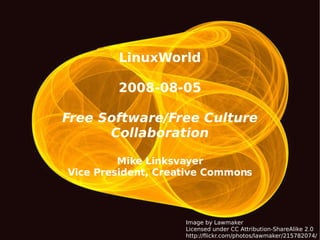
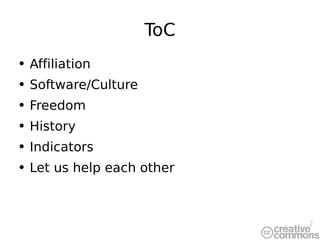
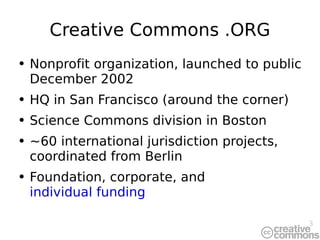
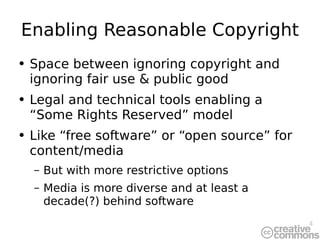
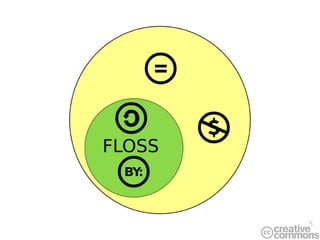
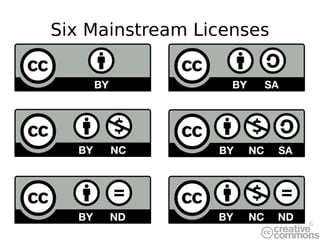
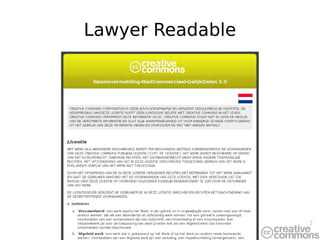
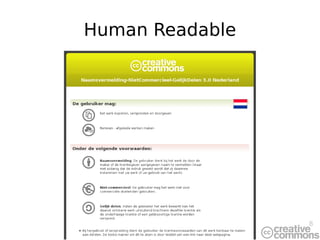
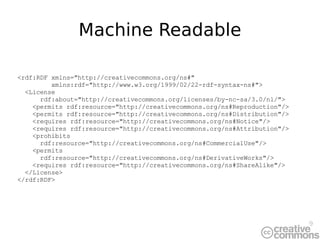
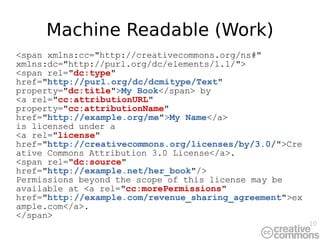
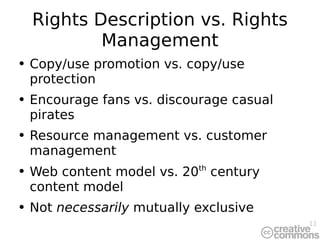
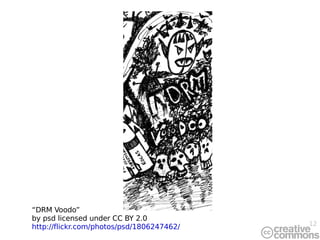
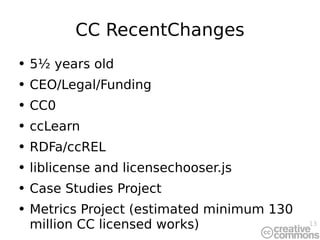
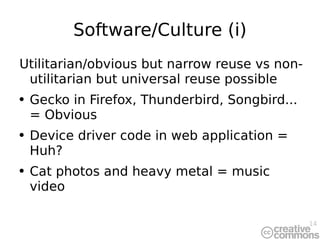
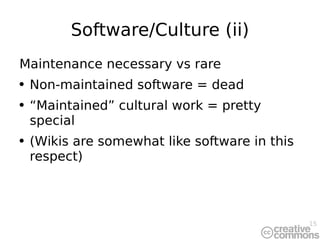
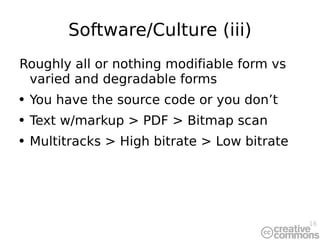


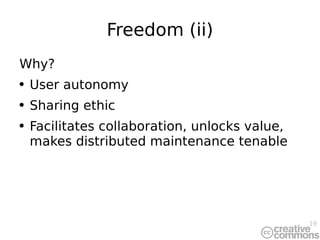
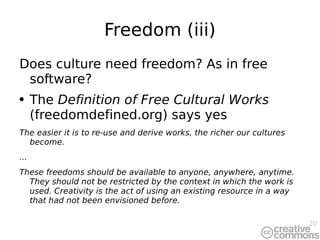
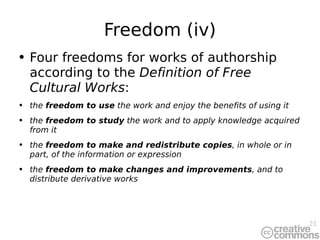
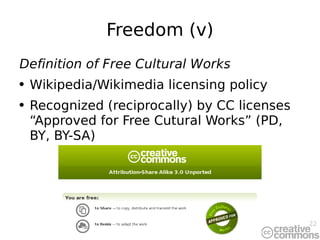
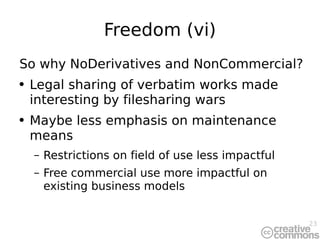
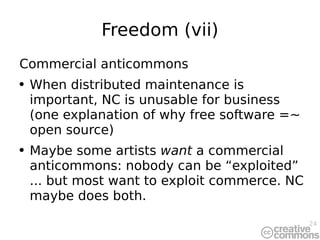
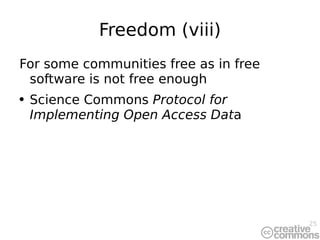
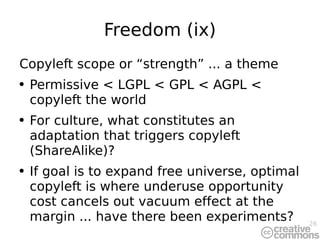
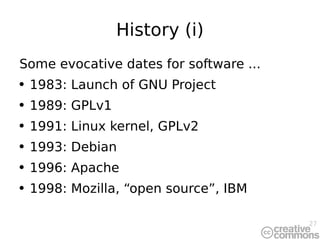
![History (ii) ... evocative dates for software 1999: crazine$$ 2004: Firefox 1.0 2007: [A]GPLv3 ????: World Domination](https://image.slidesharecdn.com/cclinuxworld20080805-1217984770944140-8/85/Free-Software-Free-Culture-Collaboration-28-320.jpg)
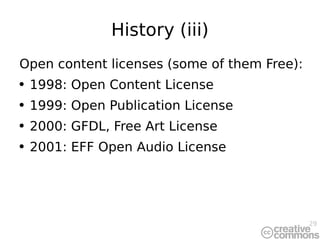
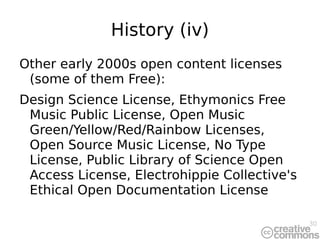
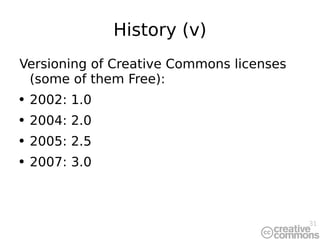
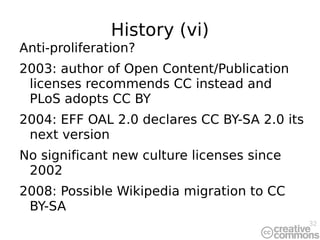
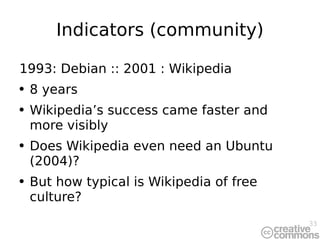
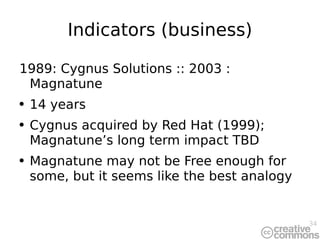
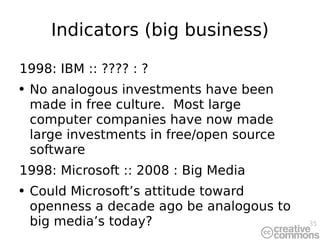
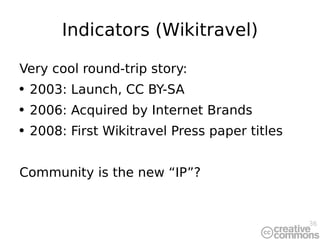
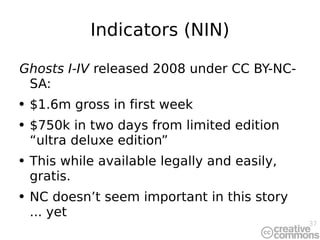
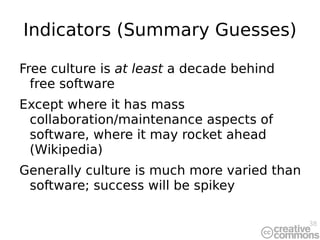
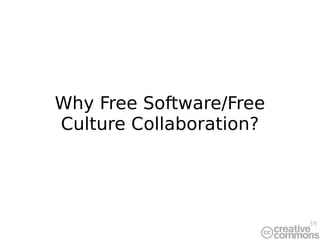
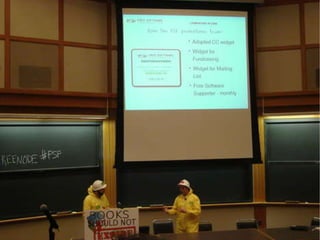
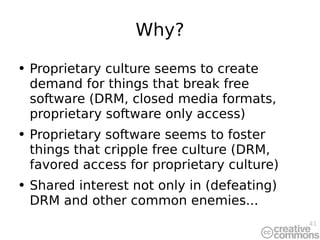
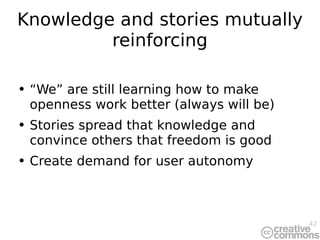
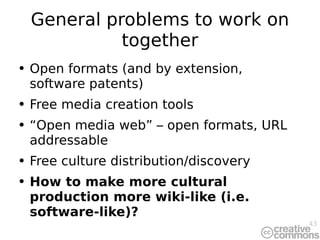
![A few currently interesting projects (large and small, of many...) Wikimedia Commons (and Wiki[mp]edia generally) Amarok, Banshee, Gnash, Miro, Rhythmbox, Songbird & co. (free software media players) liblicense and other CC software projects (all CC-produced software is free software) Severed Fifth (Jono Bacon’s free music project)](https://image.slidesharecdn.com/cclinuxworld20080805-1217984770944140-8/85/Free-Software-Free-Culture-Collaboration-44-320.jpg)
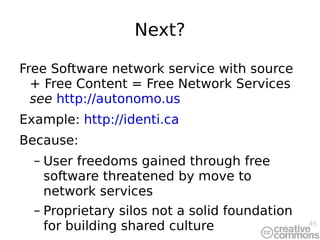
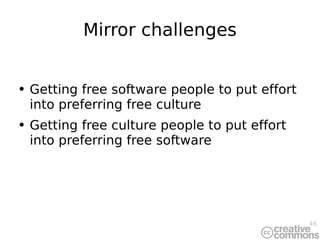
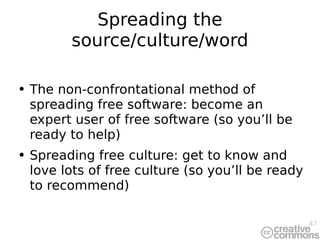

![License http://creativecommons.org/licenses/by-sa/3.0/ Attribution Author: Mike Linksvayer Link: http://creativecommons.org Questions? [email_address] Photo by believekevin Licensed under CC Attribution-ShareAlike 2.0 http://flickr.com/photos/believekevin/256875846/](https://image.slidesharecdn.com/cclinuxworld20080805-1217984770944140-8/85/Free-Software-Free-Culture-Collaboration-49-320.jpg)